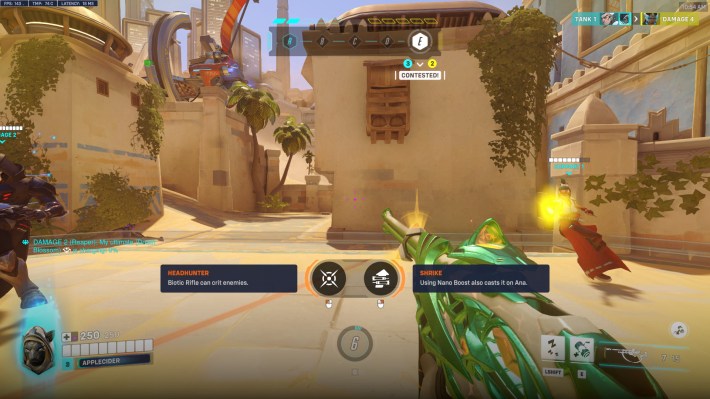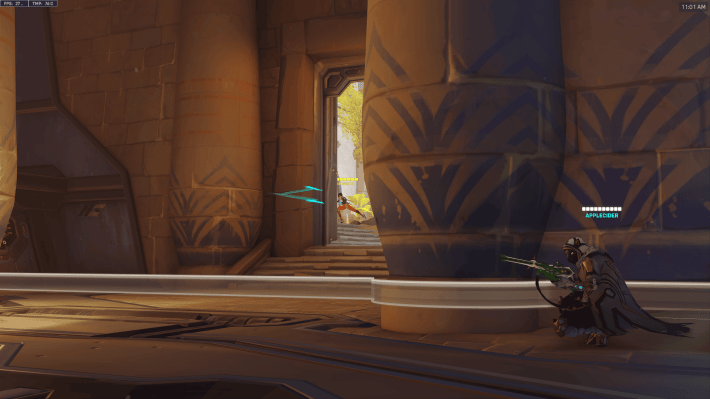Overwatch 2 is in the middle of an extended identity crisis. I feel like the game’s worried friend: I’m constantly throwing an eye over to them as they talk too loudly about how they are really into this whole new thing that’s going to change their life. I haven’t heard from them in awhile, and I just want to corner them out in the backyard and look them dead in the eye to ask, “Hey, are you doing okay?”
Two weeks ago, Overwatch’s developers and artists sketched out their roadmap for the game’s next three seasons via a splashy video at a press event on Blizzard’s campus. Hyped beforehand as “groundbreaking” changes to the game, creative director Aaron Keller announced with jazz hands that “perks” would be coming to the game in season 15. Both Keller and lead hero designer Alec Dawson emphasized that these perks, which augment hero abilities, will allow players to dramatically change their playstyle with the choices they made in matches.
While many current and past fans of the game felt excited, I felt a little alarmed. I try not to be a purist most of the time, but Overwatch has always worked best when it stuck to its guns about core design choices. Heroes are the heart of this game, and how they all synergize is what made the gameplay so innovative and fun early on. While some of that has slipped away since the confusing “sequel” release of Overwatch 2, I’ve seen brief moments of that same machinery spin up when my team comes together. Now that perks are in the game in all modes, it feels like that spirit is being buried even deeper under a change that has come in incredibly hot and confusingly mid.
Twice during a round (or match if you are in Quick Play), you are offered a choice between two ways to change some part of your hero’s kit. The first choice is for one “minor” perk, and the final choice is a more powerful “major” perk. You level your way up to this choice through specific actions in the game, like doing damage or healing to other players or assisting your team. Any time you swap heroes (which is an integral part of the gameplay), your perk “progression” is restarted on the new hero, but there are mechanics in place to help you catch back up relatively fast.
I’ve had some time to play with these perks across a few heroes in all three roles (tank, DPS and support), and I can see that we’re beta testing this feature instead of getting something polished. Perks feel clunky in both form factor and execution. Everything about them has some level of inconsistency or complication that points to either a lack of clear direction or maybe even time. It also overloads what was already a tactically complicated game. Dawson, speaking to press, commented, “We think players do crave slightly more complexity than we've been giving them for a while,” but on top of hero reworks, balance changes and role passives, they add complexity but not in a way that always feels worth the trouble.

For example, Juno’s minor perk, “Familiar Vitals,” speeds up how fast her torpedoes lock onto targets, making them feel smooth for the first time since she was put into the game. It makes her healing and damage burst ability easier to use, and feels like a much better pick than her other minor perk, Hyper Boost, which pushes her forward when she uses her Glide Boost ability through her Hyper Ring. The perk makes it feel like I no longer need expert timing to use her torpedoes to triage teammates or damage enemies, but I don’t like that I have to choose between perks for this feeling, instead of it being a change to her base ability to make it work better.
Hanzo’s “Sonic Disruption” minor perk allows his Sonic Arrow to hack nearby health packs for 12 seconds. Not only is this somewhat counter to what the main use of Sonic Arrow is (giving temporary sight through walls for teammates), but it is a confusing overlap with Sombra, whose hack ability already works on health packs. Several other damage and tank heroes have perks that heal teammates (Sombra’s White Hat, or Winston’s Revitalizing Barrier), which seem to only be marginally useful for your team and don’t quite work in the game’s more spread out positioning. These perks confusingly obscure the hero fantasy that each character symbolizes, despite Dawson saying the goal of perks is “...to identify the creative ways players are already using heroes and designing perks that serve that fantasy.”
When I look across all of the different perks heroes have, many fall across incredibly different axes between goofy and useful, from confusing to truly game-changing as promised. They come from a variety of places: limited time arcade modes, community experimental modes, and also old Overwatch 1 abilities that were reworked out of existence. Some heroes genuinely have their gameplay improved with perks, but others have been given perks that don’t make sense for their role. It has made trying to wrap my head around how I feel about perks even harder.
Inconsistencies in hero design also impact perks. Characters with more straightforward abilities, such as hitscan characters, feel like they acquire perks faster in gameplay, in contrast to a more niche damage-dealer like Genji. This is due to how participation in kills, healing and assists can vary between heroes who predominantly spam heals or damage, and ones who are more slow and niche in combat. This is further impacted by player skill, which might be a hurdle for newer players. As a Moira main, I get my perks relatively fast without even trying, but when playing heroes I had less familiarity with, it felt way harder and less fun.
Interacting with perks via the UI is also another issue that needs tweaking. Perk progression is tracked under your health bar and lets you know you’ve gotten one with a subtle chime and animation, and it is entirely possible to ignore it the entire match. Once you engage (with a keybind), two options for perks pop up over your screen and you select with the left or right mouse button. The entire process, especially now that everyone is learning what the perks even are, is confusing in the middle of fast-paced fights. I’ve found myself at least once having to wait on taking a perk, then discreetly ducking around a corner to read and press buttons correctly. It is much better to hold off until after a fight is over or when you die.

Each perk also has a unique symbol to help you identify it either as you pick it or as it appears on the in-match scoreboard, displayed for both your team and the enemy team. As there are currently 42 heroes in the game, that’s 168 icons. While there will only ever be two per person, they can swap often if people play other heroes or if they are reset on specific map modes in ranked games. There’s also some suggestion from developers that they may switch them per season or rework them.
All of this is supposed to be for fun, but I’m not sure who it should be fun for and when. Many of my favorite heroes have at least one decent or fun perk, but very few add something radically new or tactically interesting enough to be exciting to use. Also given what the developers have said about perks taking precedence over the base hero mechanics, I suspect this is also what will be their tuning pegs for balance in the future.
I can see the vision with how all of this is supposed to work, mostly because similar kinds of mechanics have been in other competitive games. It just makes me question why Overwatch, a game that innovated the entire “team shooter” genre with roles and MOBA-esque mechanics, decided to port in something from other games wholesale. It feels like a move from a game that emphasized teamwork to one that worries about making sure every single player gets to play in a way tailored to their specific idea of fun.
Perks feel like the result of a lot of internal worries about a seemingly stagnant game, but they don’t meaningfully land in a way that makes the game any more fun to play. As someone who’s poured several thousands of hours into this game, it feels like a topical fix to a much deeper set of root issues that have been spidering their way through the game’s foundation. We’re back at the party with the friend who is excitedly wanting to rearrange their life again, but the excitement reads more like anxiety or a lack of confidence. Prior to this, that anxiety came out as fussing constantly with balance, adding in passives or, even farther back, removing a tank from the team.
Overwatch 2 feels like a development team barely surviving their parent company’s demands, from Overwatch 1 being saddled with an esports league to the game going free-to-play and still needing to turn a profit. I have always tried to underscore my criticisms of the franchise as a whole with a deep empathy towards the developers and incredible artisans. They are the ones who carried this game forward through former creator director Jeff Kaplan leaving, the lawsuits at Activision-Blizzard, pandemic lockdowns, mass layoffs and what have to be incredible internal pressures for saleability in a much different industry climate from when the game started. They still do incredible work, and they care so hard about this game. I can’t possibly know how all of these decisions are made, but the impact left on me is one of confusion.
The live service space has been evolving over the last 10 years, but it has already made quick work of trying to pull as much money out of players for as many things as possible, selling as many cross-brand collaborations as possible, and making players crave novelty in order to stay inside games for as long as possible before they move onto the next thing. You see it with streamers burning through content, or with people logging into several free-to-play titles to do dailies in ad infinitum. Overwatch 2, more so than other big Blizzard titles, has been pushed to this place more and more over the past three years. It took a lot of the game’s magic with it, adding to an already jaded perception I have with Blizzard as just being another AAA studio now.
I hope the game finds its place in the future, but it says a lot about what it used to be, and still is, that I keep playing.
Nico Deyo is a freelance feminist media critic who lives in the Midwest with her cat and knows way too much about Overwatch.

